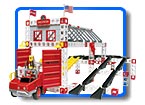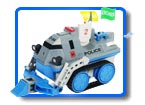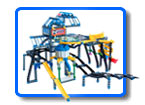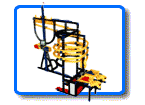| The
way children naturally explore and play with the Rokenbok system
provides a multitude of beneficial learning experiences.
Playing with Rokenbok helps children acquire useful skills for
the present and future. These learning experiences fall into four
distinct areas of learning and skills development:

Rokenbok can enhance the development of children's fine motor
skills. This comes about as the child assembles Rokenbok components
in a variety of designs and also operates the Rokenbok remote
control system, developing focused eye-hand coordination abilities.

Rokenbok can help teach social skills. Because Rokenbok works
extremely well with group play, children are able to develop a
positive approach to cooperative and "team" activity. Children
learn to communicate, share, and help others to achieve a common
goal such as in the assembly of a large operating Rokenbok structure.
This also helps children learn to manage and reduce conflict and
stress, important skills necessary in today's challenging social
environment.

The third area of learning that benefits from Rokenbok play is
perhaps the most important. Rokenbok can positively impact children's
cognitive skills development. The Rokenbok systems requires children
to think abstractly in three-dimensional patterns, and to plan
ahead in logical sequences to design, build, and play within a
unique environment of their own creation. Because Rokenbok components
can assemble into operating systems, children are also offered
the challenge of basic mechanics. Through Rokenbok, they begin
to experience the applications of geometry and physics at abstract
and tactile levels of understanding.

All of the previously discussed learning benefits of the Rokenbok
system come together to help inspire children's imagination and
ability to create their own distinctive play environments. Because
of the variety of building system components and the stimulating
Radio Control play elements, the Rokenbok system offers repeatable
creative play. This encourages a child to imagine additional designs,
configurations, and the play processes to achieve them.

|
 Site Map
Site Map








 Site Map
Site Map







